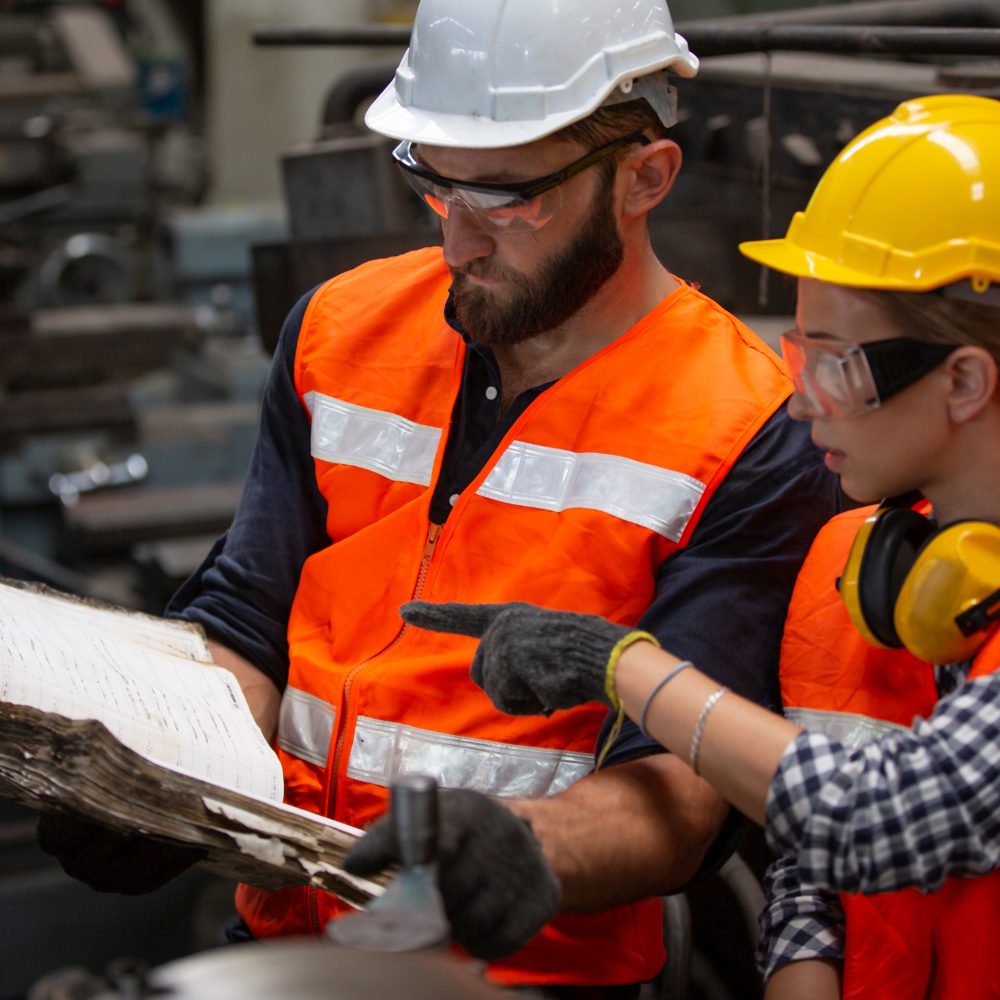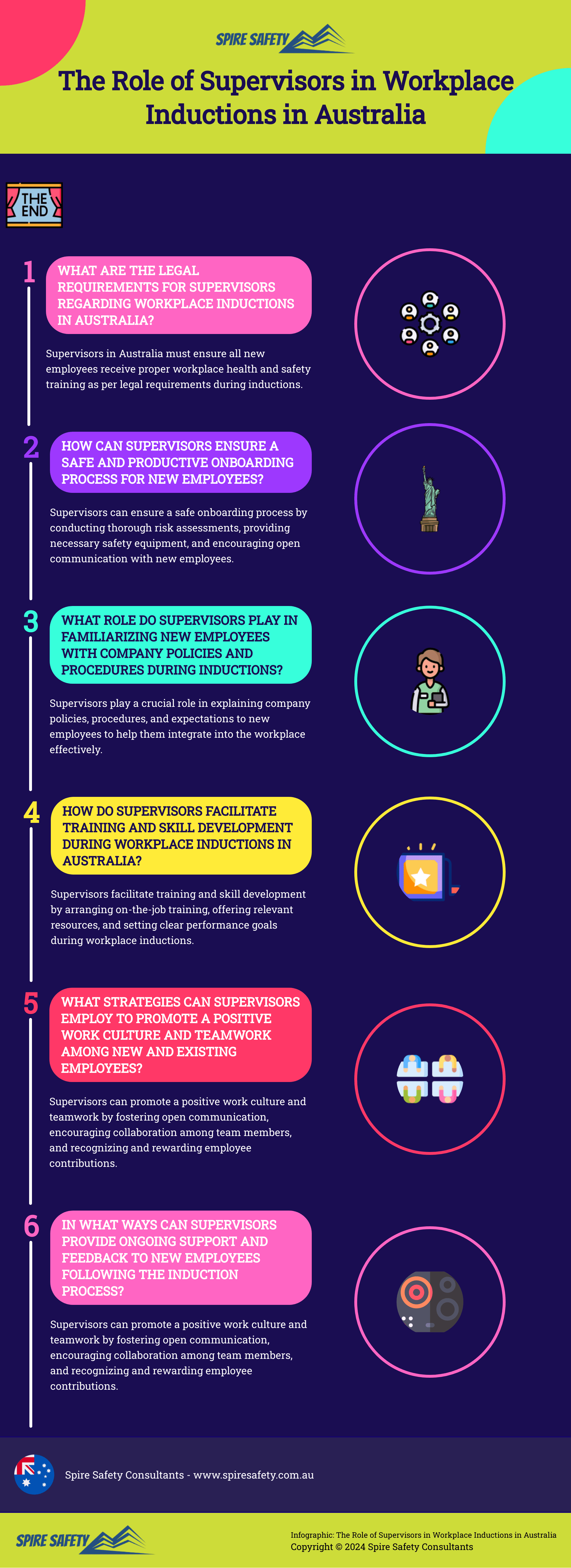In Australia, the role of supervisors in workplace inductions is pivotal to ensuring that new workers are equipped with the necessary information and skills to perform their tasks safely and effectively. A workplace induction serves as the initial step for workers and contractors before they start any work, highlighting the importance of consistent and accurate information delivery. Supervisors, by virtue of their position, play a crucial role in orchestrating this process, making sure that the induction is not just a formality but a foundational step towards a safe and productive work environment.
Supervisors are tasked with making the induction process engaging and comprehensive. They need to cover everything from workplace health and safety measures to the company’s goals and culture. Their approach to induction can significantly impact how well new employees assimilate the provided information. Therefore, it is essential for supervisors to not only convey the necessary information but to also make the induction process interactive and conducive to learning.
Moreover, the effectiveness of workplace inductions under a supervisor’s guidance can have long-term benefits for the organization. Well-inducted employees are likely to be more productive, adhere to safety protocols more strictly, and feel more connected to the company’s mission. This emphasizes the supervisor’s role as not just an enforcer of rules but as a key player in fostering a positive and safe workplace culture from day one.
Understanding the Importance of Effective Workplace Inductions
Effective workplace inductions are crucial for welcoming new hires into a business and aiding their transition into their new roles. This process not only introduces employees to their responsibilities but also embeds them into the company culture, making them feel supported and valued. The significance of a well-structured induction cannot be understated as it sets the tone for an employee’s journey within the organization, directly influencing their performance and adjustment period.
Best practice dictates that an induction program is more than a mere formality; it’s an essential strategy to increase employee retention. By providing new employees with a thorough understanding of their role, the company’s expectations, and how they fit into the wider organizational structure, businesses can significantly reduce the adjustment period. This, in turn, helps in building a strong foundation for employee loyalty and long-term engagement.
The Benefits of a Structured Induction Program
A structured induction program plays a critical role in outlining workplace policies and procedures for new starters. It ensures that employees are well-versed in their job roles, aware of the company’s goals, and understand what is expected of them in terms of performance and conduct. By systematically addressing these areas, an induction program establishes a clear pathway for new employees to follow, significantly contributing to their confidence and capability in their new roles.
Moreover, such programs offer tangible benefits for both employers and employees. For employers, a well-executed induction process fosters a positive workplace culture, encourages employee retention, and enhances operational efficiency. Employees, on the other hand, benefit from a sense of belonging, a clearer understanding of their roles, and a safer work environment, thanks to detailed workplace health and safety instructions. This mutual benefit underscores the importance of a comprehensive induction strategy.
Aligning Employees with the Company’s Mission, Goals, and Values
Aligning employees with the company’s mission, goals, and values is a fundamental aspect of any induction program. This alignment process helps new hires understand the broader context of their work and how their contributions aid in achieving the company’s objectives. It fosters a sense of purpose and belonging, which is crucial for long-term engagement and loyalty.
Through a detailed introduction to the company’s ethos and aspirations, employees are better equipped to see the value in their work. This understanding encourages a deeper commitment to the company’s vision, inspiring employees to strive for excellence in their respective roles. The role of supervisors in effectively communicating and embodying these values cannot be overstated, as they set the tone for the induction experience.
Enhancing Employee Engagement and Retention
Enhancing employee engagement and retention starts from day one, with effective induction being a critical component. Supervisors play a key role in ensuring that new workers receive comprehensive instruction, training, and supervision. This not only ensures that they are competent to work safely but also helps in building a strong connection with the company. By providing a detailed overview of workplace health and safety practices and involving employees in the identification of hazards, supervisors can foster a culture of safety and inclusion.
Moreover, involving employees in the development of safe work procedures and risk assessments further enhances their engagement. This collaborative approach not only improves safety outcomes but also gives employees a sense of ownership and responsibility towards their work environment. Consequently, this can lead to higher job satisfaction and lower employee turnover, as workers feel valued and part of a cohesive team.
The Impact of Inductions on Reducing Employee Turnover
A well-designed employee induction program can significantly reduce employee turnover by setting a positive trajectory for new hires from the outset. By providing clear information on job roles, expectations, and the company culture, inductions help mitigate the uncertainties that can lead to job dissatisfaction and eventual resignation. This initial investment in a new employee’s understanding and comfort within the company pays dividends in the form of loyalty and long-term commitment.
The correlation between effective inductions and reduced employee turnover is backed by the notion that employees who feel welcomed, valued, and well-informed are more likely to stay with the company. Supervisors, by ensuring that the induction process is comprehensive and engaging, play a crucial role in fostering this sense of belonging and commitment. Thus, a well-executed induction is not just beneficial for the employee but is a strategic advantage for the organization.
Preparing for the First Day: A Checklist for Success
To ensure a smooth integration of new employees into the workplace, it is crucial to have a comprehensive induction checklist. This checklist should outline all critical areas to be covered during the initial days, weeks, and months on the job. It defines who is responsible for each aspect of the induction, guaranteeing that new employees gain a solid understanding of their role and responsibilities, as well as the company’s expectations of them. Tailoring this checklist to suit the specific needs of your business enhances the effectiveness of the workplace induction process.
The checklist serves as a roadmap for supervisors and HR personnel, ensuring that no critical step is overlooked. From workplace tours to detailed discussions about safety protocols, each item on the checklist plays a crucial role in acclimatizing new hires. By meticulously following this guide, businesses can foster a welcoming and supportive environment that encourages new employees to adapt quickly and efficiently to their new roles.
Importance of a Warm Welcome and Initial Orientation
A warm welcome and thorough initial orientation are the cornerstones of any successful induction program. From the moment new employees step into the workplace, it’s vital to make them feel valued and part of the team. An orientation session that covers the company’s history, mission, values, and culture, alongside a detailed explanation of their role and its significance within the company, helps new hires align their personal goals with those of the organization.
Additionally, introducing new employees to their colleagues and providing a tour of the facilities can significantly ease their transition. Assigning a mentor or a go-to colleague for the first few weeks can also provide support and guidance, facilitating a smoother acclimation to the new work environment. This approach not only helps in building a strong rapport among team members but also boosts the confidence of new hires.
The initial days are crucial for setting the tone of an employee’s journey with the company. Ensuring that they have access to all necessary tools, resources, and information from day one can dramatically impact their productivity and satisfaction levels. A structured and warm welcome sets the stage for a positive and engaging workplace experience.
Ongoing Support and Induction for Existing Employees
Induction isn’t just for new hires; existing employees transitioning to new roles or returning from extended leave can also benefit from a refresher or targeted induction program. This process helps them understand new duties, expectations, and processes, ensuring they’re up to speed with any changes that have occurred in their absence. Additionally, it’s an opportunity to address any skill gaps through targeted training sessions, thereby enhancing their performance in the new role.
Such ongoing support and induction are essential for maintaining a high level of staff performance and managing conflict in the workplace effectively. By investing in continuous development and re-induction programs, companies demonstrate a commitment to their employees’ growth and well-being. This not only aids in retaining talent but also ensures that all team members are aligned with the company’s goals and updated on any changes, including those related to hazardous chemicals and safety protocols.
Strategies for Continuous Employee Development
For continuous employee development, implementing an effective induction strategy is paramount. This involves a comprehensive risk assessment to identify potential training needs and the formulation of safe work procedures to mitigate risks. Regularly updating and customizing induction content ensures that employees are well-informed and equipped to handle their roles effectively.
Moreover, incorporating feedback mechanisms into the induction process allows for the continuous improvement of training methods and materials. This adaptive approach ensures that induction programs remain relevant and effective, fostering a culture of learning and safety within the workplace. By prioritizing employee development, businesses can ensure a well-trained, competent workforce that is capable of adapting to evolving workplace demands.
Fostering a Culture of Safety and Inclusion
Creating a culture of safety and inclusion within the workplace is essential for the well-being and productivity of employees. Health and safety representatives play a crucial role in this process, acting as a bridge between the workforce and management. These representatives are instrumental in conveying the concerns and suggestions of employees, contributing valuable insights that can shape safety initiatives and policies.
By supporting health and safety representatives and providing them with the necessary resources, businesses can enhance their safety protocols and foster an environment where employees feel valued and protected. Regular consultations with these representatives can help identify high-risk areas and ensure compliance with health and safety regulations, thereby promoting a culture of safety and inclusion that benefits everyone in the organization.
Encouraging Social Interaction Among New and Existing Staff
Integrating new staff into an existing team can be challenging, but fostering social interaction from day one can significantly ease this transition. A guided tour of the workplace, introductions to team members, and assigning a buddy or mentor are effective strategies to encourage immediate engagement. Activities such as group meetings, welcome cards, and informal team lunches can further promote a sense of belonging among new employees.
It’s essential not to stop efforts to encourage social interaction after the initial introduction period. Continuous efforts to integrate new employees into the social fabric of the team are crucial for long-term engagement and team cohesion. Social interaction plays a fundamental role in building a supportive and inclusive workplace culture, enhancing job satisfaction, and improving overall team performance.
Activities and Initiatives to Enhance Team Cohesion
Team cohesion is vital for a productive and harmonious work environment. Organizing team-building activities and social events can significantly enhance relationships among team members. These initiatives should aim to foster communication, collaboration, and trust within the team.

Whether it’s through problem-solving exercises, creative projects, or social outings, such activities can break down barriers and encourage open dialogue among employees. By investing in initiatives that promote team cohesion, companies can build a more united and efficient workforce, ready to tackle challenges and achieve common goals together.
Ensuring Compliance with Health and Safety Regulations
Compliance with health and safety regulations is a non-negotiable aspect of workplace management. Health and safety representatives play a pivotal role in ensuring that these standards are not only met but integrated into the daily operations of the business. Their involvement in identifying potential hazards and advocating for safer work practices helps in creating a secure environment for all employees.
Regular training sessions, safety drills, and updates on safety regulations are essential components of maintaining a compliant and safe workplace. Engaging with health and safety representatives to review and refine safety policies ensures that the business remains up-to-date with the latest standards and practices, safeguarding the well-being of its workforce.
Role of Supervisors in Communicating and Enforcing Safety Measures
Supervisors play a crucial role in communicating and enforcing safety measures within the workplace. They are responsible for ensuring that all employees are aware of and adhere to safe work method statements and other safety protocols. Supervisors act as the first line of defense against workplace accidents, making their role in safety management indispensable.
Through regular safety briefings, training sessions, and monitoring compliance, supervisors help cultivate a culture of safety that minimizes risks and promotes the health and well-being of every staff member. Their proactive approach in identifying potential hazards and implementing corrective measures is vital in maintaining a safe and secure working environment.
Evaluating and Improving Induction Outcomes
Evaluating and improving induction outcomes is essential for the continued success of any induction program. By assessing the effectiveness of current induction programs, organizations can identify areas for improvement and adapt their strategies accordingly. This ongoing process ensures that the induction experience remains relevant, engaging, and beneficial for all participants.
Regular feedback from new employees and supervisors involved in the induction process provides invaluable insights into the program’s strengths and weaknesses. This feedback can then be used to refine the induction content, methods, and delivery, ensuring that it meets the evolving needs of the organization and its workforce.
Ultimately, the goal is to create an induction experience that not only equips new hires with the knowledge and skills they need to succeed but also fosters a sense of belonging and commitment to the company’s mission and values. By continuously evaluating and improving induction outcomes, businesses can enhance employee engagement, retention, and overall performance.
The Role of Feedback in Refining the Induction Experience
Feedback is a critical component in refining the induction experience. It allows organizations to gain insights into the effectiveness of their induction programs and identify opportunities for enhancement. Encouraging new hires to share their thoughts and experiences can shed light on aspects of the induction that work well and those that may require adjustment.
Actively seeking feedback from participants at various stages of the induction process enables companies to make timely improvements, ensuring that the program remains responsive to the needs of new employees. This iterative process helps in creating a more engaging and informative induction experience that supports the successful integration of employees into the company.
Methods for Gathering and Implementing Employee Feedback
Gathering and implementing employee feedback effectively requires a structured approach. Surveys, interviews, and focus groups are valuable tools for collecting detailed feedback on the induction process. These methods provide employees with various platforms to express their views and suggest improvements.
Once collected, it’s crucial for organizations to analyze this feedback and identify actionable insights. Implementing changes based on employee suggestions demonstrates a commitment to continuous improvement and can significantly enhance the quality and effectiveness of safe work procedures and the overall induction experience.
Following-Up: The Key to Successful Long-Term Induction
Effective induction does not end after the initial welcome period; follow-up is crucial for long-term success. Ensuring that each staff member is provided with ongoing support and resources is essential for their continuous development and integration into the company. Regular check-ins allow supervisors to address any concerns and provide additional guidance as needed.
Moreover, revisiting safety policies and procedures with new hires ensures that they remain aware and compliant with workplace safety standards. This ongoing engagement helps solidify the knowledge and practices introduced during induction, promoting a safer and more inclusive workplace for everyone.
Regular Check-Ins and Adjustments to the Induction Program
Regular check-ins serve as a critical component of the induction program, ensuring that new employees are adjusting well and understanding their roles. These sessions provide an opportunity for supervisors to address any concerns, offer guidance, and make necessary adjustments to the induction program based on feedback. Such a proactive approach not only enhances the employee’s initial experience but also contributes to their long-term success within the organization.
Adjusting the induction program is essential for keeping it relevant and effective. As each employee brings a unique set of skills and experiences, the flexibility to tailor the program to individual needs is crucial. Supervisors play a vital role in this process, utilizing their insights from regular check-ins to refine and enhance the program. This continuous improvement cycle ensures that the induction process remains a robust foundation for new employees, aligning them with the company’s mission and values from the outset.
Maximising the Impact of Workplace Inductions
Maximizing the impact of workplace inductions hinges on the commitment and involvement of supervisors throughout the process. By embracing their pivotal role, supervisors ensure that new employees are not only provided with an induction that covers the essentials of their roles but are also integrated into the company culture. This holistic approach to induction lays the groundwork for a productive, engaged, and loyal workforce, contributing significantly to the organization’s overall success.
Furthermore, the effectiveness of workplace inductions is amplified when supervisors actively seek and implement feedback from new employees. This iterative process of refinement ensures that induction processes remain dynamic, addressing the evolving needs of the workforce and the organization. Ultimately, the role of supervisors in shaping a positive induction experience cannot be overstated, as it directly impacts employee satisfaction, retention, and performance.
The Critical Role of Supervisors in Shaping the Induction Experience
Supervisors are instrumental in shaping a positive induction experience, serving as the primary point of contact for new employees. They are responsible for communicating the organization’s expectations, providing an overview of the probation process, and ensuring that new hires are aware of and attend relevant orientation and induction programs. This includes imparting essential work health and safety information, highlighting any necessary safety training, and discussing workplace hazards. Supervisors also play a crucial role in facilitating introductions to key colleagues and mentors, thereby fostering a supportive work environment from day one.
In addition to these responsibilities, supervisors must ensure that new employees understand their legal obligations and the organization’s policies on professional behaviour. This encompasses the obligation to notify the employer of any circumstances that might require workplace reasonable adjustments, such as injury, illness, or disability. By providing a comprehensive induction that covers these aspects, supervisors lay the foundation for a smooth transition into the workplace, ensuring that new hires feel valued and supported.
Furthermore, supervisors have the vital task of monitoring the mental health of new employees, and offering guidance and support as needed. This aspect of the induction process is critical for fostering a healthy and inclusive workplace culture. By prioritizing the well-being of new hires and addressing any concerns promptly, supervisors not only enhance the induction experience but also contribute to the long-term success and retention of employees within the organization.
Continuous Improvement for Future Induction Success
Continuous improvement of the induction process is essential for its future success. By regularly evaluating the effectiveness of the induction program, supervisors can identify areas for enhancement, ensuring that the program evolves to meet the changing needs of the organization and its workforce. This involves gathering and acting on feedback from new employees, making adjustments to the program content, and exploring innovative approaches to induction, such as leveraging technology for more efficient and engaging experiences.
Adopting a flexible and responsive approach to induction programming allows supervisors to tailor the process to the unique needs of each new hire, thereby maximizing its impact. This personalized approach not only facilitates a smoother transition for new employees but also reinforces the organization’s commitment to their development and well-being. Through continuous refinement, supervisors can ensure that the induction program remains a key driver of employee engagement, satisfaction, and retention.
Ultimately, the success of future induction processes hinges on the organization’s willingness to invest in its continuous improvement. By prioritizing the development of comprehensive and adaptive induction programs, supervisors can play a pivotal role in nurturing a skilled, motivated, and cohesive workforce. This forward-thinking approach to induction is crucial for fostering a culture of excellence and innovation within the workplace.
FAQ
1. What is the role of supervisors in workplace inductions in Australia? Supervisors play a crucial role in workplace inductions by overseeing the process, ensuring compliance with safety regulations, and providing guidance to new employees.
2. How can supervisors contribute to a successful workplace induction? Supervisors can contribute by being present during the induction, explaining job-specific tasks and safety procedures, and fostering a positive work culture.
3. What are the legal responsibilities of supervisors in workplace inductions? Supervisors are responsible for ensuring that new employees receive adequate training on workplace health and safety, as required by the Work Health and Safety Act 2011.
4. How can supervisors promote a safe working environment during inductions? Supervisors can promote safety by demonstrating safe work practices, highlighting potential hazards, and emphasizing the importance of following safety protocols.
5. How do supervisors support new employees during the induction process? Supervisors can support new employees by answering questions, providing feedback, and helping them integrate into the team.
6. What are the benefits of involving supervisors in workplace inductions? Involving supervisors can lead to smoother transitions for new employees, improved safety awareness, and increased employee engagement and retention.
7. How can supervisors ensure that workplace inductions are effective and engaging? Supervisors can ensure effectiveness by tailoring the induction to the individual needs of new employees, using interactive training methods, and seeking feedback for continuous improvement.
8. What should supervisors do if they encounter challenges during the induction process? Supervisors should address challenges promptly by seeking support from higher management, revising the induction process if necessary, and providing additional training or resources as needed.
Advice & Actionable Tips
To ensure supervisors effectively contribute to workplace inductions:
- Conduct regular training for supervisors on their role in inductions.
- Provide supervisors with resources and tools to facilitate inductions.
- Encourage supervisors to lead by example in following safety procedures.
- Foster open communication between supervisors and new employees.
- Recognize and reward supervisors for their contributions to successful inductions.









